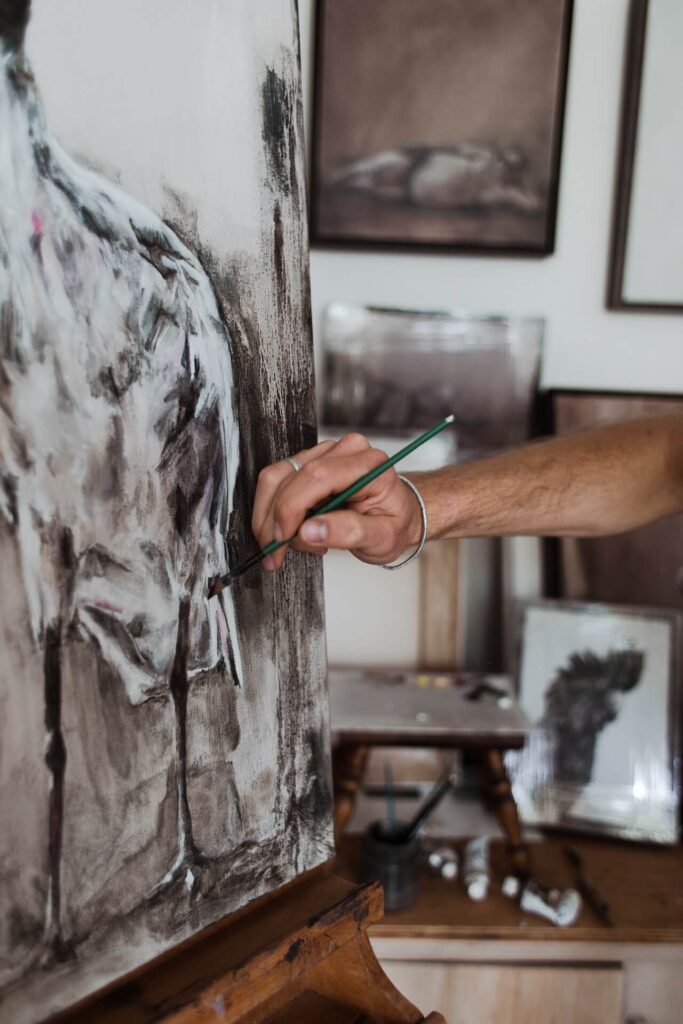
When it comes to selling, there are three types of products: candy, vitamins, and painkillers. (And also those sticky hands from the 90s.)
If you want to do laps in a swimming pool while nibbling on turkey and olives and just letting the sales pour in before wrapping yourself in an Armani robe, well, painkiller products will get you there faster: AKA something that solves a “headache” that people have. Think: “I really gotta lose this chub.” = “Hire a weight loss coach.” Or “My toilet is leaking” = “I need a plumber.”
Vitamins, on the other hand, are products that would be nice to have, but they’re not necessarily top priority. Sure, do I want a mindset coach to help me become a better version of myself? (And stop tweeting about hot dogs?) (God, pls follow my new account so I don’t look like I’m sitting at picnic by myself.) Absolutely. But, do I recognize this as a problem that needs to be solved? Not really. I don’t wake up at night thinking that I really need a new mindset. Therefore, when most people see something like that advertised, they tend to think “oh, that sounds lovely!” and then immediately jump back into their life’s must-solve problems first. Vitamin products are products that can easily be put off until a person is in a better place / they’re making more money / they have more time / they have more motivation / they’re not scared to dive into the depths of their own despair. 🤷♀️ So, they’re harder to sell.
Finally, candy is the stuff like video games that are seriously just FUN. It’s all about pleasure, but it might not even really be good for you. *EYES BOTTLE OF WINE*
Painkillers are the easiest type of product to sell for the most amount of money: they solve an immediate problem that people can recognize as a problem—this is key—and therefore, people are willing to spend money on it. A lot of money. Everyone’s willing to spend money to solve problems that hurt them. This is why copywriters get paid way more money than fiction writers: copywriting produces sales for businesses, while novel writing produces pleasure.
This is also why, when I first got on the phone with Danny Gregory, founder of Sketchbook Skool, the very first thing I said to him was: “HOW’S IT BEEN, SELLING A VITAMIN?!”
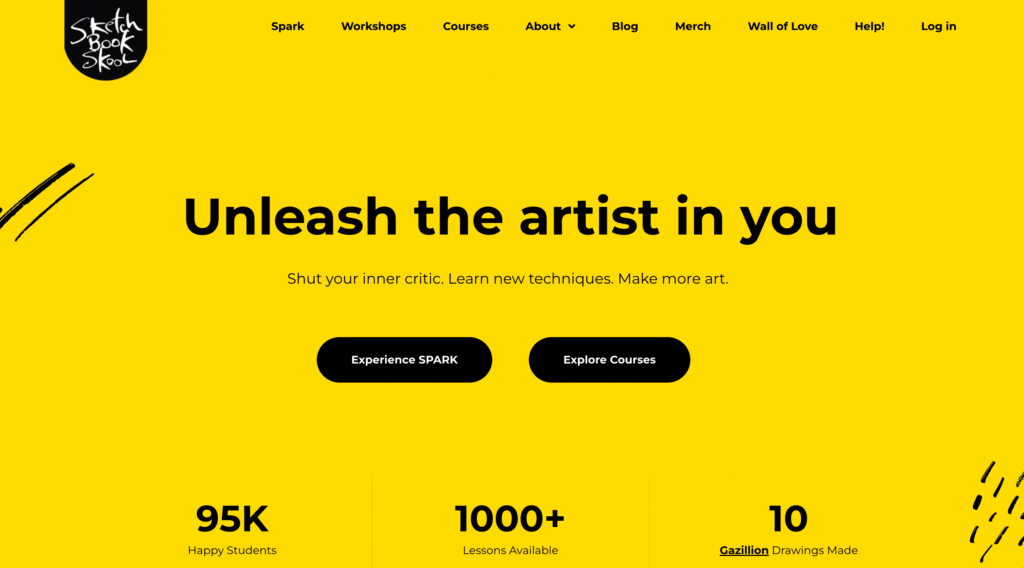
Sketchbook Skool is an online drawing school for people who can hardly draw a straight line. Case in point: their best-selling course is called—wait for it—How to Draw Without Talent. (Psst, you get 50% off with the code THEVIVETTE. 😍) Another one that instantly grabs my attention: How to Paint a Pub. And I’m thinking: yes! This is a type of art I can get on board with! (Especially because it’s a British pub.)
But still: this is the kind of thing that is clearly a vitamin product. No one needs to learn how to sketch. So, how was Danny Gregory making so much money doing it?
This is what I set out to find out.
What I learn, however, is that Danny’s entire business is more about pain than I think.
He just figured out how to turn it into art.
But first, let me just drop a few truth nugs:
- Over 75,000 students from all over the world have taken Danny’s drawing classes online 🌎
- Some people come and take two to three hours of art classes A DAY 😲
- The school is generating one million dollars a year 🌟
- The revenue is divided between a membership ($130/mo), courses ($49 – $99), and skill-specific workshops ($75)
- Most customers are women, age 45+ (especially after they learned how to use Zoom during the pandemic)
- And he’s got 15 art instructors on contract giving workshops inside the school. His favorite are retired art teachers: “they make the best teachers!”
I am flabbergasted by his seeming ability to be everywhere, doing everything.
He’s also got a podcast!
And he writes essays twice a week!
Then, he turns one of the essays into a video for his YouTube channel!
Then, he teaches a free workshop on YouTube every Thursday!
Then, he speaks about creativity at places like Columbia! The American Institute of Architects! The U.S. Senate!
Not to mention that he’s the author of—ready for this?—twelve books. NOT A TYPO. (The book, How to Draw Without Talent, was adapted from the course after it became his most popular course—perhaps a useful lesson in repurposing your content).
On the outside looking in, you’d think he was just really prolific—and a whiz at online business. And, you would be right. But the truth is, the reason why Danny Gregory does all of this has nothing to do with chasing success.
Not since the accident, anyway.
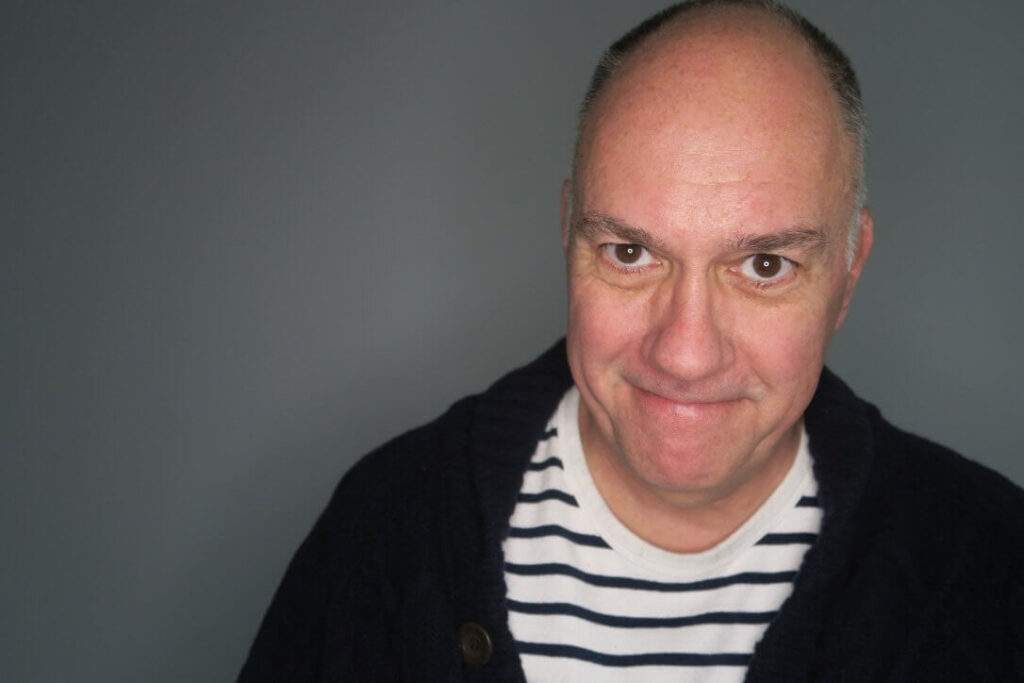
At the beginning of our conversation, when I first mentioned the word “painkiller,” Danny knew exactly what I was talking about…without me walking him through my long-winded hot dog spiel. In a former life, he was a BIG cheese 🧀 at an advertising agency in New York City.
But, he wasn’t an artist—he was a writer and producer.
He and his wife lived in a nice apartment in Greenwich Village, in Manhattan. He was doing creative work for big clients like Chevron. Patti was a stylist who ran around Manhattan collecting fashionable clothes for photo shoots.
They’d just had a baby: a boy named Jack.
Jack was ten months old.
He was at a photoshoot himself when he got the news.
”We thought we had it made in our lives,” he tells me. “My wife, the fashionable lifestyle, we just had our baby—everything’s going great and then suddenly, in one second it all changes.”
Her spine was crushed. Her back was broken. A freak subway accident. She had fallen off the platform and onto the tracks, just as the #9 train was arriving. Three subway cars rolled over Patti’s body. Patti wouldn’t be able to walk for the rest of her life.
They were in their thirties.
He spent the next year trying to find an explanation for how something so terrible could happen to them. His worldview was shattered; he tried so hard to find a positive response. But, he was mad. As he described in his book: “What I wanted to know was ‘what next?’ How do we remake our lives and be happy again? How do we get outta here?!?”
One day, he needed to document the contents of their medicine cabinet. There were so many things in that medicine cabinet. He decided to draw what he saw. Without expecting it, a feeling of presence and calm came over him. It was the first time he’d been able to find calm for a really long time.
It surprised him, as he wasn’t an artist.
The next day, he decided to draw Patti.
”She’s sitting on the couch and I, you know, hadn’t really drawn a person or done anything like that, but there was something about drawing her that was really very different from how I had come to see her in the course of the time since her accident. I saw her like she was—the real her—not just ‘her as a problem,’ which is, unfortunately, how I had come to see the situation.”
Danny started carrying a sketchbook around with him everywhere: he would have it when he walked to work, he would have it when he sat in meetings, and and in that process, everything he drew connected him to how lucky he really was.
It’s then that he circles back to the idea of pain. “Everything I’ve done is rooted in pain,” he says. He tells me that other people are in pain—they’ve suppressed their creative urges for so long—and that’s why they spend two to three hours drawing in Sketchbook Skool every day.
”It’s personal empowerment through art,” he explains. So much so, that during one of the very first drawing classes he ever gave, someone commented: “This doesn’t feel like art class; it feels like self help.”
And really, if you watch any of Danny’s videos, you’ll see he’s like a personal development guru in disguise. (The best kind.) He’s got a whole section called “Advice for Creative People” and speaking to him feels like wrapping a warm blanket around your shoulders: comforting, soothing, self-assured, calm.
He credits drawing for that.
He credits drawing for most of the happiness he’s found in his life.

Danny didn’t quit his career in advertising right away, but he did start writing books. His book, Everyday Matters, published by Hachette, documents his journey teaching himself how to draw, and how he rediscovered himself through art.
Fifteen years after the accident, Patti passed away.
He wrote another book titled A Kiss Before You Go: Memoir of Loss and Love, published by Chronicle, chronicles his grief via drawings.
Eventually, Danny realized he didn’t want to spend another minute of his life sitting in meetings. His son was fifteen years old, by then. And they both had their whole lives ahead of them.
“And suddenly everything was up for grabs from me: what do I do, where do I go?”
He moved across the country to L.A. and gave his first online drawing class. He’d met a Dutch artist, and together they decided to put together their first course. Thanks to his book writing efforts, he had already had started to make a name for himself. He even had a Yahoo community, back then, and says that some of those earliest followers are still with him today.
Thousands of people showed up to that first class.
Not because Danny Gregory was some kind of online marketing whiz, but because he had grown so passionate about his subject, you couldn’t go anywhere in the drawing world without hearing his name.
But, he did have certain advantages.
Coming from the world of advertising, he was used to making things and having millions of people see it. In fact, he missed that public aspect of his work. So, he set out to create world-class courses with high production value—the kind he was used to—instead of with a webcam.
It worked.
Their earliest drawing classes were artistic documentaries sitting in real artist studios, talking with each artist about their career, and then having the artist do a demonstration, and then ending with an assignment for the student.
Nine years later, however, Sketchbook Skool is much more instructional—and less targeted at working artists, and more targeted at everyday people who need to reinvigorate their sense of creativity…and maybe even themselves.
(Though the production value is still wildly unreal.)
I asked Danny if he could tell us what he uses to record these magnificent, professionally-produced videos, and in true artist form, he replied with this drawing (which I am saving forever):
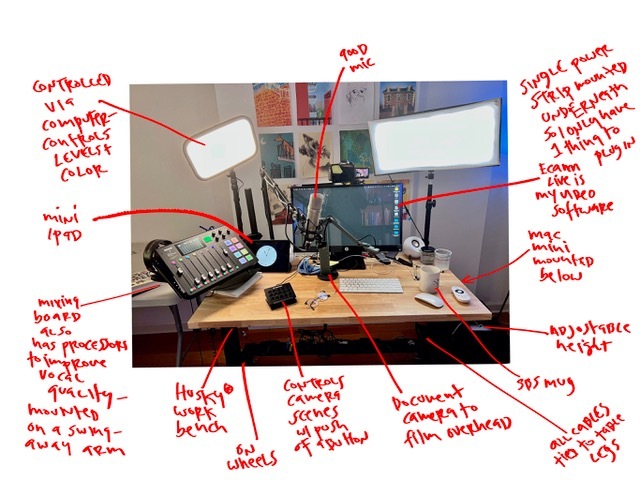
Then, he said this (in case you want to replicate!)
I film myself from a love using a simple doodad called a document camera. Imagine a desk lamp with a camera instead of a light that you can put right over your work and record to your computer. I discovered that such a thing existed at NYU, and it turns out teachers use them all the time. I used to have all sorts of elaborate and cumbersome rigs to do the same, and the doc camera is a godsend. I buy one for all of our teachers. I stream to Facebook (and a couple of YouTube channels, too) using eCamm Live and Restream. I also have a dedicated desk with light and camera and computers all bolted onto it. I call it Rolling Thunder because it’s on wheels and I can move it anywhere in the house or even into the garden and stream from anywhere.
So, now let’s talk about how the school operates today, and then we’ll talk about marketing. Everybody’s favorite!
The Sketchbook Skool Business Model
Sketchbook Skool’s Spark Membership ($130/mo)—Biggest Driver of Revenue
- This is the delicious bread and butter of Sketchbook Skool. 🥖 🧈 It’s a membership that offers more than 20 live classes a week—this is where his art teacher contractors come in—the class recording library, and a private artist community.
- Sketchbook Skool currently has 500 paying subscribers that generates $50k+ MRR (monthly recurring revenue). Total: $600K per year in membership fees.
- During the live classes, you can show your work on camera and get immediate feedback from instructors. (LOVE.)
- The inspiration from this was actually from Peloton!
- This live, hands-on model has been very effective in terms of helping to turn this “vitamin” product into something people BEG FOR. Danny says: “It works because you have an appointment. What we found is that if you show up and there are other people there and they’re doing it you so much more likely to come again and do it again, and just give yourself an hour to make something. We’re constantly reinforcing this idea that it’s more important to just do stuff so you can learn skills as you’re doing it.”
- This has been exceptionally true in my own experience: today’s learners really enjoy—and benefit from—coming together as a group, at a specific time, to create in unity, “with an appointment,” if you will. It’s a much different experience than a DIY course, though those certainly have their place and value as well. However, this is a useful lesson for those who are selling a vitamin product: live workshops work. Because they’re happening at a specific place and time, and because if they don’t show up, they miss out, it helps people get over the hump of “that’s nice but do I really need to do it now???” Yes, yes, you do. This is called urgency, and it’s a critical component of selling in an online environment. Am I saying you need to use *false* urgency? Of course not. But this model has built-in legitimate urgency that works beautifully to get people over their own mental hurdles…and you new customers.
- On pricing, here’s what Danny said: “You know, the first reaction is that this is expensive, because $130 a month is expensive if you don’t know what this is; if you don’t know what you’re comparing it to. So, it is expensive when you compare it to Skillshare or Udemy or one of these other platforms that sell online courses where you can get a month for like $9. And people say, well, why would I sign up for this? But then, when they start to understand it’s live in a small group with a teacher who will answer your questions and you will make a huge amount of art, because you’re showing up? Well, it’s a game changer. If you do anything a lot, you’ll get good at it.”
- Danny also offers a free 14-day trial, and when I asked him about it, he confirmed that this had been effective in terms of converting strangers into customers. This seems to be a key when you’re selling “vitamin” products: you need every advantage to get a person into building a habit with you. More on this below, when we talk marketing.
- However, it can still be a challenge to get folks off the street to subscribe to a membership—it’s a big ask—so that’s where the rest comes in. ⬇️
Sketchbook Courses ($49 – $99)
- These are 4-6 week foundational courses that may be live, or they may be on-demand.
- Danny’s best-selling course is “How to Draw Without Talent” (again, you get 50% off with the code THEVIVETTE) and it serves as awesome “gateway drug” into his world. He’s sold over 15,000 of them to date! 🤯
- Courses typically run two to four weeks in length.
- There’s a 30-day guarantee—helpful for first timers who may not yet trust the brand.
- Important: all students get lifetime access to the private artist community (they use Mighty Networks, though he thinks that the new Circle is probably better…and I really dig Circle, myself!), even if they never take another class with them again. This is an interesting approach: I haven’t seen this done before, but Danny’s such a superstar with this. Typically communities are reserved for higher-priced memberships and masterminds. However, Danny’s goal is to impact as many people’s lives as possible, and by making them feel included in the community, they come back and buy more. But also, here’s a hidden benefit: “We have a social platform, which is really an important part of it. It used to be on Facebook—that was a nightmare—and that right there, so we started a thing, where basically it’s a closed community on our own platform that’s just for our students and that’s where you can come and share your work and get feedback, but you can also ask questions, and you can talk to other people who get it. That’s been a real big part of it, because a lot of people said, you know, ‘I don’t want to post it on Facebook because then my cousin who always makes fun of me is gonna be like, oh so you think you’re an artist now?’”
- Offering one-off courses like these have been an awesome way to get new subscribers into the Spark Membership: they’re an easy “yes” and let people “try out” a course without feeling like they’re committing to a membership…even if there’s a 14-day free trial. (The psychology of the commitment still stings.)
- All this said, it may be worth considering how to meet people at the top of the funnel—i.e. in the very beginning of their journey, a la “How to Draw Without Talent”—so they can grow with you over the long-term.
- A customer may not be ready to “be an artist” yet, but these smaller courses serve as a vehicle to get them into the greater ecosystem of everything Danny. 😍
Sketchbook Workshops ($75)
- Shorter, quick hits
- Live and on-demand
- Only a couple hours long
- These are deep dives into a specific topic or idea
- This is also an easy “yes” product, since it’s a small commitment, it’s easy to consume, it’s at an easy price point, and it’s easier than getting someone to sign up to do the “work” of a 6-week course…especially if they don’t believe in their art yet, or they’re telling themselves the narrative that they’re never really going to commit / finish / follow through, so it’s silly to purchase a course. (This is a big obstacle in the course world right now.)
- This is helpful because it can help bridge revenue gaps between “just found you and it’s Saturday and let me do some drawing!” and “I love Danny and this school and I’m going to enroll in a 6-week course.”
- So in reality, what we’ve got here is a step ladder of commitment: a baby workshop…a bigger 6-week course…and finally, a $130/mo membership. While you may be tempted to assume this is redundant, it’s a great strategy for building trust—and you’d be surprised, but once people take one baby workshop, they realize how little they know (and how much you do!) and so then that one baby workshop helps to sell your bigger stuff…without you doing anything else. The beauty of this, of course, is that you can create these to be consumed on-demand, so you aren’t giving them live all of the time. It’s an excellent way to give your people what they need, while making sure you don’t overwhelm your resources. (AKA YOU.)
What’s working really well here, however, is that making art is not a one-and-done kind of deal for the people who have found magic in it: it becomes a daily practice, and that’s why the membership sells so easily. It’s much harder to sell a membership if your clients or students only anticipate using your stuff every once in a while. So, by Danny positioning his work this way—as an important daily practice—and making sure his students CAN CREATE a daily practice in his membership, he keeps ’em for life.
Therefore, there’s value in considering how you can design your work into a daily practice. Is there a daily habit you can architect for clients, customers, students? I’ve seen brilliant success with my daily newsletter for punching up your writing, Meat & Hair, because folks like to start their day with it. We’ve got a high 55% open rate, and they tell me all the time it helps them find their voice and put them into a creative writing zone. (And in fact, I’m working on building out a creative writing school, so Danny’s experience here is huge. 🌟)
It’s one thing to build a school, however, and another thing to market it. So let’s shift gears and talk about that—because Danny is doing something BRILLIANT that has been mindblowingly effective.
His biggest source of new customers?
YouTube.
He tells me that a majority of their students come from Danny’s free, live “Draw With Me” sessions that he does every single Thursday at noon Eastern on YouTube, where they have 142,000 subscribers.
(During the pandemic, he did one every day, and hundreds of people would show up to draw with him.)
“YouTube has ended up being a really important marketing tool for me.”
So he’s not really marketing himself as much as he is becoming a cheerleader for other people to rediscover their own creative urges.
He shows up rain or shine and does a live sketch for you to follow along.
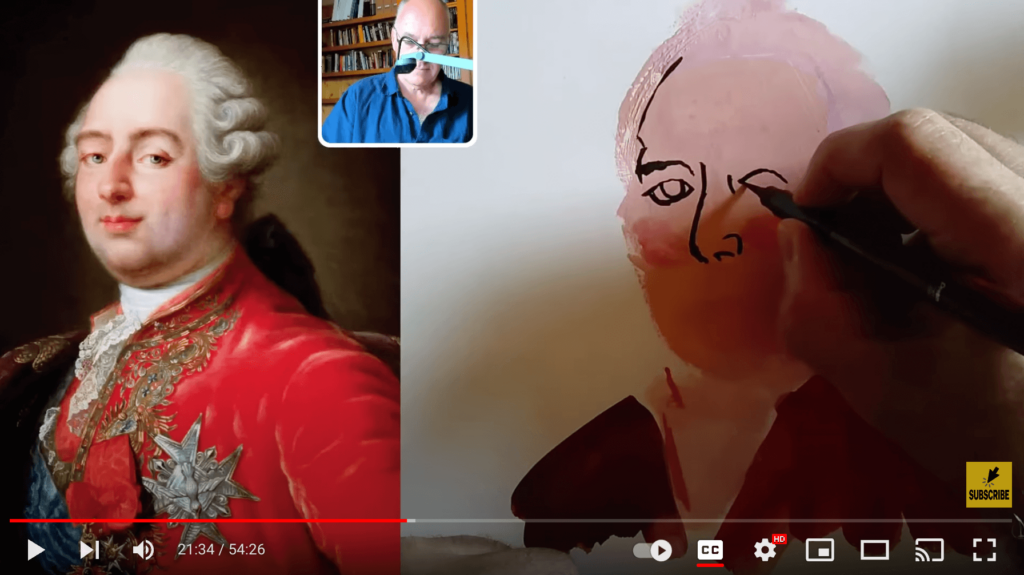
Most people would assume this would result in less customers, since they don’t have to pay for a workshop: they can just do it for free on YouTube with Danny. But time and time again, experience has shown that actually the exact opposite happens.
- People find you
- They engage with your work
- They see your passion and enthusiasm
- They give it a try (what the hell, they don’t have to risk embarrassing themselves if they aren’t paying)
- They love it
- They subscribe
- They do it again
- They start laughing at Danny’s jokes, feeling like they know him
- Suddenly, they make a habit out of it. They feel like Danny’s a part of their lives.
- Finally, they see a paid offer and think, “Oh, I love Danny—I’m so going to do this with him.”
- Price sensitivity has been reduced, too, because they value Danny’s brand so much: it’s worth $130/mo. They wouldn’t pay that to a stranger, but they’ll pay it to Danny. They want to be a part of this.
- Also: reciprocity: they feel as if they owe a great deal of debt to Danny for all his time.
- Furthermore, they have little doubt that he’ll deliver: if I loved the free channel this much, imagine how glorious the membership will be.
Giving away your work for free is, counterintuitively, the easiest way to get paid a lot of money.
In fact, it’s necessary: you cannot stay quiet and remain on the sidelines and then expect the brand to sell itself.
All brands require cheerleaders, and Danny’s a natural.
Once the YouTube video finishes, he then prompts you to subscribe to his email list, Danny’s Essays—which is an important part of any online business strategy. (He now has 17,000 email subscribers!)
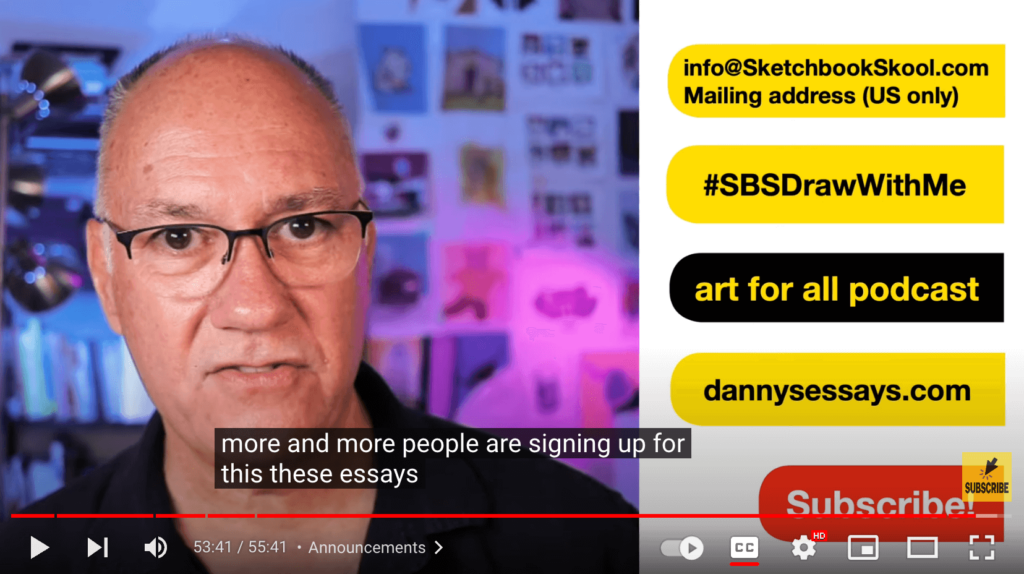
This is a good gateway to talk about what else this magician has going on behind the scenes. Beyond YouTube, he markets his work in four other big ways:
- A podcast, called Art for All, which offers creative inspiration and advice to help you stop procrastinating and start making stuff. (The podcast has 240,000 downloads at the time of this writing!)
- As mentioned, he incredibly weekly essay, called Danny’s Essays, that he sends out every Friday for creative people. He’s got 17,000 email subscribers! He uses a lead magnet as extra incentive to get on the list. The lead magnet is called “Never Feel Guilty About Making Art,” and it’s a collection of essays to get you into a mode to create.
- A general mailing list for Sketchbook Skool, which now has 100,000 email subscribers. What they do here is publish content to their blog, and then send out a round-up every month.
- And, of course, the 12 books that Danny’s authored with major publishers like Penguin, serving to spread his message far and wide.
It’s useful to see how he’s able to reposition his message across a variety of mediums. While you might worry this would start to feel redundant, it has the opposite effect: Danny’s message is CLEAR:
“Everyone has the same opportunity. Not to become a professional artist, but to make art into a regular part of your everyday life. It doesn’t matter what your elementary school art teacher said, or your parents, or your boss. You have it in you to draw, to play an instrument, to write poetry, whatever you choose. You can and should express yourself. Regardless of what you fear anyone else may thinks of the results, you can become a creative person and achieve a new view of the life you lead.”
And, that’s exactly what he does for people: Danny gives them a new lens with which to view the world.
As we wrap up, I ask him what his plans are for the day. He tells me that he’s editing footage. Making a series of videos for teachers. Writing an essay that’s coming out tomorrow. Making plans for a new podcast.
But, what he’s really doing is leading.
He’s not editing footage: he’s putting together a video to make people see the world around them through a fresh lens, the way he once did.
He’s not making a series of videos for teachers: he’s rallying a team on a mission.
He’s not writing an essay: he’s sending out a compassionate call to arms.
He’s not making plans for a new podcast: he’s yelling through the universe, no longer frustrated at its inability to be understood, but rather enjoying every single moment he gets on earth, to understand.
Danny is the living embodiment of this time-honored truth: don’t start a brand, start a mission.
And when I visit his YouTube channel this week, I find even more proof:
Not something he’s made for YouTube, but something he’s made for you.
And I can’t help but think that maybe all of marketing can be boiled down to that one line. And maybe all of life can be boiled down to a drawing on the page, just waiting for you to show up and get started.
“The single-minded quest for fame and success inevitably invites compromise. You will sell your soul for remarkably little. Desperation for acceptance means clinging to the yellow lines in the middle of the road. You will strain to avoid offending anybody so you can reach the broadest audience. You will contort your ideas to anticipate objections and to please the algorithm. You will dumb yourself down to be accessible. It turns out though, that you can’t fool the world. You can’t control the process. The machines may not be that smart. But most people actually are. And they can see through this game. You can’t hack your way to glory. Instead of following some surefire way to online success, make something just for you. Stuff that you would like. Stuff that grows from your experience, your truth, your heart. Most genuinely successful artists don’t begin by chasing success. Sure, they’re driven to work hard. Very hard. But that’s because they’re deeply passionate about what they are making—not because they have a formula for success.” —Danny Gregory in this YouTube address, How to Reach Millions With Your Art